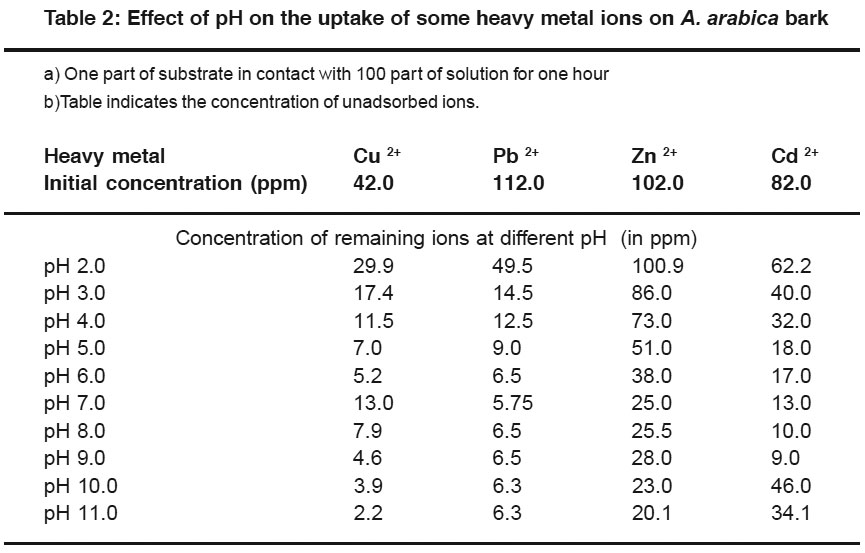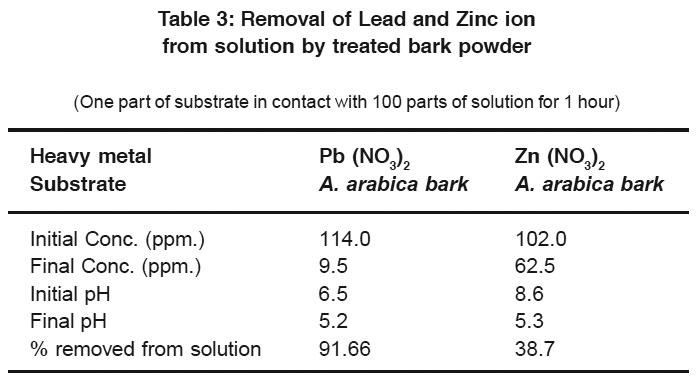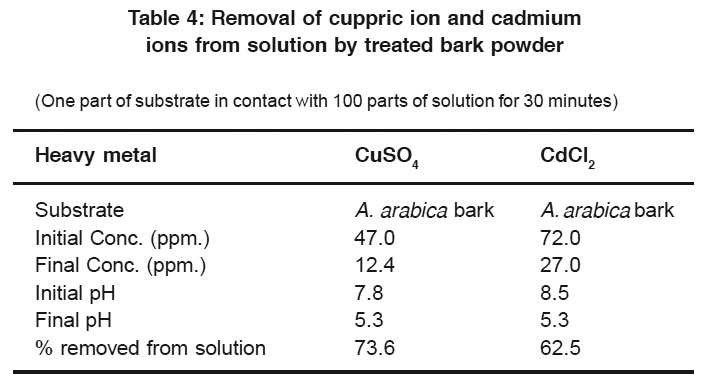Adsorption studies of toxic heavy metals from waste water by Acacia arabica bark
Dhananjay Dwivedi1 * and Vijay R. Chourey2
1
Department of Chemistry,
P.M.B. Gujarati Science College,
Indore,
452 001
India
2
Government Holkar Autonomous Science College,
Indore,
452 001
India
DOI: http://dx.doi.org/10.12944/CWE.4.1.29
The adsorption technique using chemically treated powder of bark of Acacia arabica was applied for the removal of toxic heavy metals from polluted waste water. The extent of adsorption found to be dependent on the pH and the time of contact. The adsorbent is effective for the quantitative removal of various toxic metals from the contaminated aqueous sample. The method is quite feasible, economic and time saving. The concentration of unadsorbed metals were determined by atomic absorption spectrophotometer. The applicability of bark of Acacia arbica was tested for the removal of Cu2+, Pb2+, Zn2+ and Cd2+ ions from aqueous sampl
Copy the following to cite this article:
Dwivedi D, Chourey V.R. Adsorption studies of toxic heavy metals from waste water by Acacia arabica bark. Curr World Environ 2009;4(1):179-182 DOI:http://dx.doi.org/10.12944/CWE.4.1.29
Copy the following to cite this URL:
Dwivedi D, Chourey V.R. Adsorption studies of toxic heavy metals from waste water by Acacia arabica bark. Curr World Environ 2009;4(1):179-182. Available from: http://www.cwejournal.org/?p=931
Download article (pdf)
Citation Manager
Publish History
Select type of program for download
| Endnote EndNote format (Mac & Win) | |
| Reference Manager Ris format (Win only) | |
| Procite Ris format (Win only) | |
| Medlars Format | |
| RefWorks Format RefWorks format (Mac & Win) | |
| BibTex Format BibTex format (Mac & Win) |
Article Publishing History
| Received: | 2009-03-15 |
|---|---|
| Accepted: | 2009-05-03 |
Introduction
The contribution of heavy metals and their ions to water pollution is a very serious problem, largely because the physiological effects of some of them may be dangerous even at concentrations that are extremely low. Waste water containing heavy metal ion mainly originates from metal processing industries, chemical industries and other industrial processes.1,2,3
In recent years considerable attention has been devoted to the study of different types of low cost material2,4,5 such as Guargum chitin, tamarind kernal powder (TKP), Ferronia elefuntum, fruit shell (bark) etc. Some investigators have used carbonaceous precursors like pearl millet husk, date pits, saw dust, buffing dust of leather industry, coir pith, crude oil residue, tropical grass, olive stone, almond shell, pinebark, wool waste, coconut shell, dried stem of pandonus etc. For the removal of metal ion from water and waste water.6,7,8
Modified barks for scavenging toxic heavy metal ions from solution has been reported by several workers.6-13 However the efficiency of the commonly available Indian barks as Acacia arabica for the removal of toxic heavy metal ions does not seem to have been evaluated. Based on this fact the purpose of this adsorption studies with low cost material is more than justified.
Material and Methods
All chemicals used were of high purity, commercially available AnalaR grade.
Chemically treated powder of bark of Acacia arabica is a raw material used as adsorbent. It was collected from the locally available sources, cleaned with hot water and dried at 550C for 48 hours. Dried and grinded powder were sieved to achieve an average particle size (0.2 mm), homogenized and stored in clean bag until further treatment. A mixture of one part of 40% aqueous formaldehyde solution and 20 parts by volume of 0.2N H2SO4 was heated at 55°C then, 2.5 parts by weight of grinded bark was added in it. This mixture was stirred for two hours at 55°C and filtered through sintered glass funnel. The residue was washed with distilled cold water until the pH of the filtrate achieved to 4 to 5.
 |
Table 1: Change in pH of water sample having bark powder (One part of substrate in contact with 100 ml of water) Click here to view table |
Experimental
The stock solution of synthetic waste water containing 1000 mg. dm-3 of metal ions Cu2+, Pb2+, Zn2+, Cd2+ was prepared using metal salts. Test solutions were prepared from stock solution having concentration of metal ion in ppm.
 |
Table 2: Effect of pH on the uptake of some heavy metal ions on A. arabica bark ​​​​​​​Click here to view table |
One gram of the powder of treated bark and 100 ml of a test solutions containing heavy metal ions were gently agitated at room temperature for an hour. The mixture was filtered and analysed for trace metal by atomic absorption spectrophotometer. The quantity of heavy metal ions adsorbed on bark was determined by measuring their initial and final concentration in the solution.
 |
Table 3: Removal of Lead and Zinc ion from solution by treated bark powder ​​​​​​​Click here to view table |
 |
Table 4: Removal of cuppric ion and cadmium ions from solution by treated bark powder ​​​​​​​Click here to view table |
Results and Discussion
The pH level of doubly distilled water solution and the water containing bark powder (One gram of bark per 100 ml of distilled water) were measured after one hour and then after 48 hours. The results have been reported in the table-1. It can be seen that the pH of the equilibrium solution vary from 4.9 to 5.9.
Thus their resultant pH levels can have some effect on the binding of heavy metals. In the continuous operation the soluble acids quickly leached out from the bark and carried away the metal ion from the test solution.
The concentration of heavy metal ions (ppm) in solution at different pH-values with one gm of the A. arabica bark ( Babul) have also been measured. The pH of the solution in all the cases has been adjusted with sodium hydroxide and dilute nitric acid. The results have been given in the table 2. It shows that at pH 1, there is no uptake of metal ions by the substrate. It can be seen from the table that maximum uptake of lead ions occurs at pH 7, copper and zinc at pH 11, while cadmium ions occur at pH 9. In all cases, the uptake of the meal ions initially reaches a maximum value as the pH is increased and then it fluctuates.
The adsorption of lead and zinc ion from their nitrate solutions have also been evaluated. It is observed that modified bark adsorb lead ions quite well. The percentage of lead and zinc ions removed from the nitrate solution is 91.66% and 38.7% respectively as reported in the Table 3.
Results obtained for removal of copper ions and cadmium ions from their sulphate and chloride salts have been given in the table IV. The percentage of copper ions & cadmium ions removed were found 73.6% & 62.5% respectively.
Conclusion
The modified and treated bark sample of Acacia arabica (Babul) is applied, which is most commonly available in India and is inexpensive. The present studies have appreciable affinity for finding the heavy metal ions like Cu2+, Pb2+, Zn2+ & Cd2+. Randall and Coworkers8-9 have demonstrated the binding of heavy metal ions on the western bark sample is pH dependent, because Tannin in the bark act as a weak acid ion exchanger i.e. exchanging two hydrogen ions in the solution for each divalent metal ion bound to the solid.
Acknowledgements
Authors acknowledges sincere thanks to Dr. O.P. Joshi, Principal, PMB Gujarati Science College, Indore for providing the necessary facilities and for kind support.
References
- Levinson A.A. “Introduction of Exploration Geochemistry” Applied publishing Ltd., Calgary (1974).
- Gupta Vikal, Agrawal Jaya, Manisha and Purohit Veena; Res.J. Chem.Environ. (2007) 2(1): 40.
- Tuzen M. and Soylak M., Evaluation of metal levels of drinking water, Polish Journal of Environmental Studies. (2006) 6: 15.
- Larry, J. Ricci, Chem. Engg., (1975) 105: 29
- Venkatraman, B.R., Hema M. Rajchndrashekhar T. and Arivoli S., Res. J. Chem. & Environ. (2007) 11(1): 74.
- Gupta V., Agrawal J., Purohit M., Res. J. Chem. Environ. (2007) 11(1): 40.
- Singh P., Zhang W., Robins R.G., Hubbard G., Res. J. Chem. Environ. (2007) 11(1): 58.
- Randall J.M. and Waiss A.C., Jr. Forest Prod. J. (1974) 24: 80.
- Randall J.M., Hautala E. and Waiss A.C., Jr. Tschernitzj forest Prod. J. (1976) 26(8): 46.
- Randall J.M., Forest Prod. (1977) 27(11): 51.
- Poonawala N.A., Lightsey G.R., and Hiner A.L., Proc. IInd National Conf. on Complete Water Reuses, Chicago, (1975) 4-8: 241
- Hautala E. and Waiss A.C., Jr. Proc 4th Mineral Waste Utilization Sym. Chicago May, (1974) 7-8
- Reuter J.M. and Waiss A.C., J. Appl. Polym. Sci, (1978) 22: 379.






